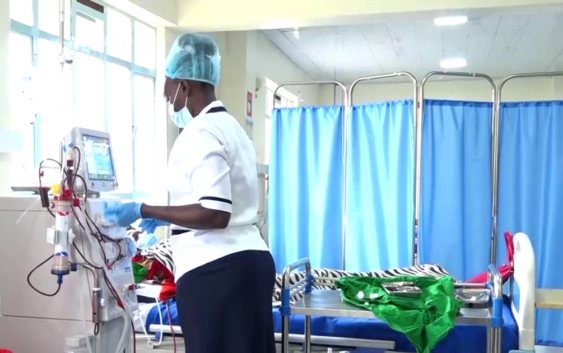- TOGO GOVT. SEEK CIVIL ENGINEERS FOR STEEL-CONCRETE BRIDGE PROJECT
- GHANA MINISTER CALLS FOR COMPLETION OF GARID PROJECT AIMED RAINY SEASON
- MPILO HOSPITAL IN NEEDS OF MASSIVE INFRASTRUCTURAL CHANGE IN ZIMBABWE
- HOW MDCB BAIL OUT BOSTWANA MINERGY OVER LOST OF COAL PRODUCTION
- WHY ACCESS TO WATER IS STILL A MAJOR ISSUE IN AFRICA
SECOND RENAL FACILITY CONSTRUCTION AT 90% COMPLETE IN KENYA

Related Post
- TOGO GOVT. SEEK CIVIL ENGINEERS FOR STEEL-CONCRETE BRIDGE PROJECT
- GHANA MINISTER CALLS FOR COMPLETION OF GARID PROJECT AIMED RAINY SEASON
- MPILO HOSPITAL IN NEEDS OF MASSIVE INFRASTRUCTURAL CHANGE IN ZIMBABWE
- HOW MDCB BAIL OUT BOSTWANA MINERGY OVER LOST OF COAL PRODUCTION
- WHY ACCESS TO WATER IS STILL A MAJOR ISSUE IN AFRICA
In a bid to bring better services, Mama Lucy is set to open a renal unit at the hospital in March. Renal unit provides hemodialysis for both in and outpatients with chronic or acute kidney disease requiring renal replacement therapy.
According to Nairobi Governor Johnson Sakaja, the renal facility is 90 per cent done. “ This will be the second one in Nairobi and will be launched on March 8,” he said.
The first renal unit in a county-owned facility was launched in 2019 at the Mbagathi Hospital.
This means that thousands of Nairobi residents residing in Eastlands will now breathe a sigh of relief as Mama Lucy will introduce dialysis sessions.
Normally, patients are required to do two dialysis sessions per week but there are cases where some go for 10 sessions in a month.
National Hospital Insurance Funds (NHIF) patients are fully covered but those who are not but seek to have it done privately are charged Sh 9,500 per session.
In the past, only Kenyatta National Hospital (KNH), Moi Teaching and Referral Hospital (MTRH) and Coast General Hospital had the equipment to handle dialysis.
Long queues, and sometimes failure by overloaded machines at KNH made the treatment of kidney disease difficult.
Back in 2015, the Ministry of Health leased Sh38 billion in medical equipment to 94 county hospitals among them dialysis machines, CT scans and MRI units.
However, with Mama Lucy now having the right equipment, will ease congestion at Mbagathi and Kenyatta National Hospital
Also, Mama Lucy hospital was recently named a level 5 facility.
Level 5 health facilities are known as county referral hospitals and should have more than 100 beds. They are run by chief executive officers who must be medical doctors.
They should be built on at least 10 acres. They must have inpatient and outpatient pharmacies, a burns unit, and staff quarters for at least eight people on duty.
Level 5 hospitals should be able to handle more than 250 patients daily and manage medical, pediatric, surgical and gynaecological in-patients.
They should provide radiology services, tuberculosis management, pathology, chemotherapy and forensic services.
Besides a medical superintendent, Level 5 hospitals should have at least 15 medical officers, seven anaesthesiologists, two cardiologists, four general surgeons and two orthopedic surgeons.
They should employ at least 90 clinical officers, 118 nurses with specialists spread across different departments, 11 pharmacists and 10 pharmaceutical technologists.
SOURCE: STAR

